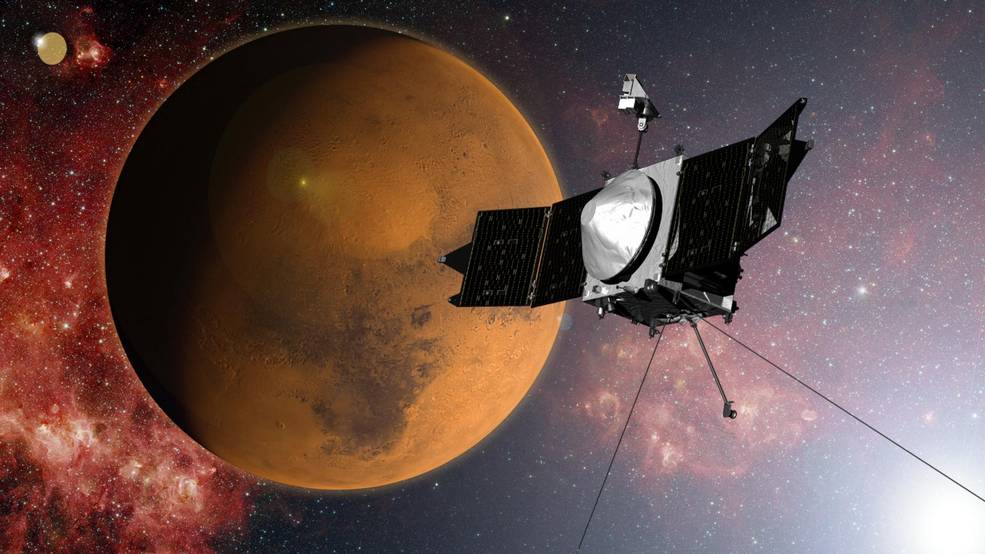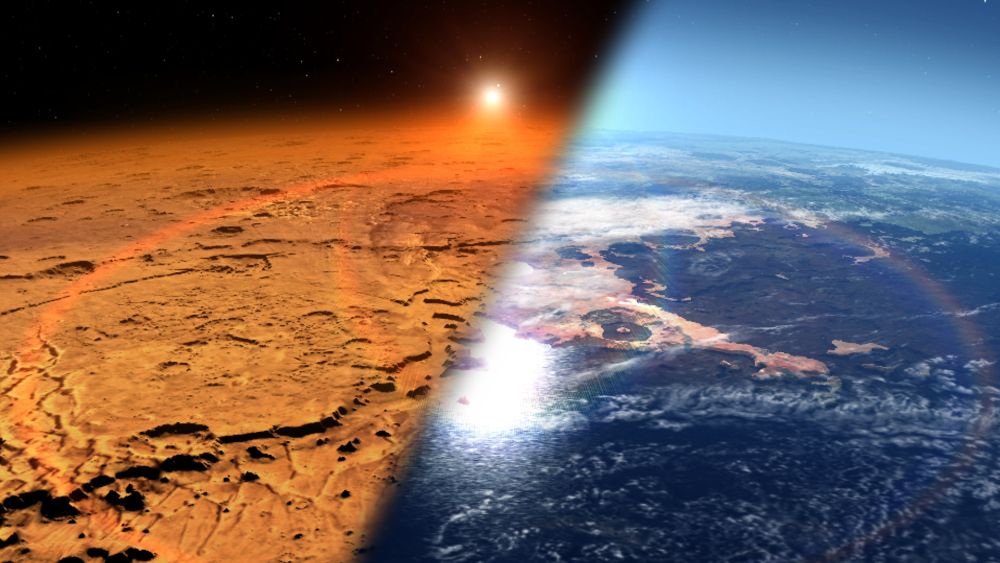Our eyes can’t see them, but Martian auroras are there, and more commonplace than we once thought. The Martian auroras were first discovered in 2016 by NASA’s MAVEN spacecraft. Now some new results are expanding our knowledge of these unusual auroras.
Most Universe Today readers know about Earth’s auroras and how they’re created. When a powerful enough solar wind strikes Earth’s magnetosphere, particles (usually electrons but sometimes protons) get excited and ionize different components in the atmosphere. That emits varying colors and shapes of light. The phenomenon creates a moving, ephemeral display that captivates the eye. Auroras are usually confined to the northern and southern polar latitudes except when the solar wind is very powerful.
Martian auroras are similar, and different.
Martian auroras are all proton auroras, and they occur during the day. They emit only ultraviolet light, which means our eyes are blind to them. But an instrument on the MAVEN (Mars Atmosphere and Volatile EvolutioN) spacecraft can see them. It’s called the Imaging UltraViolet Spectrograph (IUVS.)

MAVEN is investigating the Martian atmosphere. One of its questions is very specific: how did it lose its atmosphere? To answer that it observes the upper atmosphere, the ionosphere, and how Mars interacts with the solar wind. As part of its work, it discovered Mars’ proton auroras.
The Martian proton auroras and the loss of Mars’ atmosphere and habitability are linked. Mars is surrounded by a hydrogen corona that comes from the planet itself. As this hydrogen escapes from Mars, it creates water loss. There’s a correlation between the rate and intensity of Martian auroras and water loss.
“Perhaps one day, when interplanetary travel becomes commonplace… travelers will witness firsthand the final stages of Mars losing the remainder of its water to space.”
Andréa Hughes, Lead Author, Embry-Riddle Aeronautical University
When the solar wind from the Sun strikes Mars, it’s really just protons: hydrogen atoms with their electron stripped away by intense heat. The proton strikes the hydrogen corona, stealing an electron and becoming an atom again with a neutral charge. Since it’s now neutral, it bypasses the bow-shock of Mars’ magnetosphere. Then the atom slams into Mars’ thin atmosphere, colliding with gas molecules and emitting ultraviolet light.
“In this new study using MAVEN/IUVS data from multiple Mars years, the team has found that periods of increased atmospheric escape correspond with increases in proton aurora occurrence and intensity,” said Andréa Hughes of Embry-Riddle Aeronautical University in Daytona Beach, Florida. Hughes is lead author of a new paper titled “Proton Aurora on Mars: A Dayside Phenomenon Pervasive in Southern Summer.” It was published December 12 in the Journal of Geophysical Research, Space Physics.
“Perhaps one day, when interplanetary travel becomes commonplace, travelers arriving at Mars during southern summer will have front-row seats to observe Martian proton aurora majestically dancing across the dayside of the planet (while wearing ultraviolet-sensitive goggles, of course). These travelers will witness firsthand the final stages of Mars losing the remainder of its water to space,” Hughes said in a press release.

The first time that MAVEN spotted the Martian auroras, scientists thought it was a relatively rare phenomenon. But now they’ve found these UV proton auroras much more often. “At first, we believed that these events were rather rare because we weren’t looking at the right times and places,” said Mike Chaffin, research scientist at the University of Colorado Boulder’s Laboratory for Atmospheric and Space Physics (LASP) and second author of the study.
“But after a closer look, we found that proton aurora are occurring far more often in dayside southern summer observations than we initially expected.” The team has found proton aurora in about 14 percent of their dayside observations, which increases to more than 80 percent of the time when only dayside southern summer observations are considered. “By comparison, IUVS has detected diffuse aurora on Mars in a few percent of orbits with favorable geometry, and discrete aurora detections are rarer still in the dataset,” said Nick Schneider, coauthor and lead of the IUVS team at LASP.
The fact that these auroras are more plentiful during summer, specifically southern summer, intrigued scientists. It was a clue to how they could track Mars’ ongoing water loss. Mars is closest to the Sun during southern and summer, and therefore receiving more solar wind. The summer can also spawn huge dust storms, which not only create vast towers of dust up to 80 kilometers high, but also forces water vapor high into the atmosphere.

Solar UV breaks apart the water vapor into hydrogen and oxygen, and the increased hydrogen in Mars’ hydrogen corona means interactions between it and solar particles increases, creating UV auroras.

Credits: Embry-Riddle Aeronautical University/LASP, U. of Colorado
“All the conditions necessary to create Martian proton aurora (e.g., solar wind protons, an extended hydrogen atmosphere, and the absence of a global dipole magnetic field) are more commonly available at Mars than those needed to create other types of aurora,” said Hughes. “Also, the connection between MAVEN’s observations of increased atmospheric escape and increases in proton aurora frequency and intensity means that proton aurora can actually be used as a proxy for what’s happening in the hydrogen corona surrounding Mars, and therefore, a proxy for times of increased atmospheric escape and water loss.”
More:
- Press Release: Newfound Martian Aurora Actually the Most Common; Sheds Light on Mars’ Changing Climate
- Research Paper: Proton Aurora on Mars: A Dayside Phenomenon Pervasive in Southern Summer
- Universe Today: When Martian Storms Really Get Going, they Create Towers of Dust 80 Kilometers High
- Research Abstract: Mars Express Observations of the Hydrogen Corona of Mars

